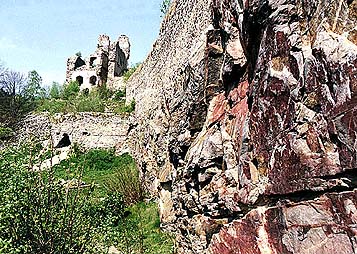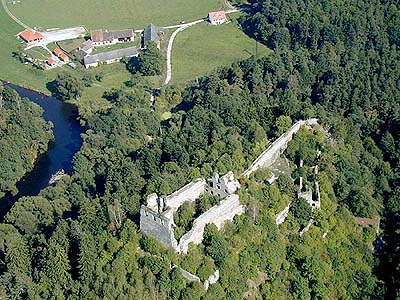Dívčí Kámen Castle
Location:
The ruins of the Dívčí Kámen castle are located near Třísov village
9 km to the north-east of Český Krumlov. The castle was situated on
a high rocky hill locked by the waters of the Vltava river and the
stream called Křemežský stream. This stream empties into the Vltava
river under the castle.
Origin of the Name :
The name of the castle originated from the German word Stein -
stone or castle and the word Maget (Mogt) - a girl or a maiden. The
castle was called either the German word Maidstein (Menštejn) or
the Czech juncture of words Dívčí Kámen ("Maiden's Stone") that is
used up to the present day.
Architectural and Historical Development
:
Within today's castle ruins a hill-side habitation was spread.
This habitation was settled during several primeval periods. The
centre of the habitation was destroyed when the castle was built,
only some remains on the north and the north-east slopes were
preserved. At the turn of the earlier and middle Bronze Ages the
fortified community was established there. It was protected with
mound from better accessible sides.
The Gothic Dívčí Kámen castle was built during two stages. Between 1350 - 1360 the residential centre with a two floor north palace and the walls around were built. The eastern palace, the third floor of the northern palace with chapel and stone wall of the extramural settlement were built before 1383. At the first half of the 15th century the extramural settlement was extended on the north side to the eastern palace tower and it was fortified with two prismatic bastions. The castle was composed of three parts - the residential castle itself, the upper barbican and extramural settlement, "latrán" (a lateral long street leading to a town) built later on the south. The Dívčí Kámen castle was a typical example of the Gothic castle architecture at the times of the emperor Karel IV. The residential centre of the castle was made of two three floor palaces that contained a regular courtyard in their closed sides. Three rooms with the wooden ceiling and the windows situated at the courtyard were on each of the floors - ground floor and two upper floors of the palace. On the third floor of the northern palace there was only one hall with windows also in the external wall and with the arch on the northern part, which opened to the bay chapel. The way to the castle ran through three castle gates.

|

|
Today the Dívčí Kámen castle with its 210 metres of length and 45 metres of width is one of the biggest castle ruins in Bohemia. Parts of the walls of the upper and lower castle and also parts of the castle fortification were preserved.
Significant Architectural Features:
The fragments of the profiled jamb-stone of the windows in the deep
niches with side seats and the stucco window and door frames in the
east palace were preserved to our times.
History of the Castle's Inhabitants:
The Dívčí Kámen castle is one of the castles in Bohemia of which
the foundation charter was preserved. Four sons of Peter I. von
Rosenberg, Petr, Jošt, Oldřich and Jan, decided to build this
castle. The emperor Karel IV gave them on July 1, 1349 permission
to "build in the Czech Kingdom the castle called in the Czech
language Dívčí Kámen and make its walls, moats, towers and other
fences strong". The castle was built a short time after this date.
The castle had from the beginning its military and administration
functions. It was the centre of the independent estates owned by
the Rosenbergs. At the time of contention between the Czech
aristocracy and king Václav IV,
in 1394 the castle became for a short time a place for the captured
king during his enforced journey to Austria. During the first years
of the Hussite war Ulrich II. von
Rosenberg passed the Dívčí Kámen castle over to Vilém z
Poštejna but in 1424 he took it back into his ownership. When
Ulrich II. von Rosenberg passed his control over the Rosenbergs
estates on his son Jan in 1457, he decided to leave for the Dívčí
Kámen castle. In 1461 he came back to the family residence in Český
Krumlov. At the beginning of the 16th century the castle's
function as a fort slowly diminished but for all that it was
reconstructed in 1506. The expenses on its care and maintenance
were too high and that was why Petr IV z Rožmberka decided not to
keep the castle any longer. The last burgrave was discharged, the
left furniture was moved in the chests in the Český Krumlov castle
and castle itself was abandoned. Petr V z Rožmberka wrote in the
provincial register that "Meidštejn - the ruined castle" is the
part of his Český Krumlov estates. Many stones from the castle were
taken away by the local farmers to build their houses. The
impressive ruins of the castle dominating the landscape were
preserved until today.
Tales and legends:
A young Rosenberg called Jošt hounded a hind deer. Suddenly it
disappeared near a high rock above the Vltava river. Instead of it
a beautiful pale maiden appeared on the rock and Jošt lost his
heart to her. The girl did not trust his words of love unproved by
any feat. To prove his given word he built the castle on the rock
and named it Dívčí Kámen. Another legend says that the poor
herds-woman did not reciprocate the lord of Rosenberg but he kept
on loving her for all his life and the castle was named after her
stony heart. The legend also says that Jošt built the castle for
one of his five daughters to hide there before the secular
demoralisation. The backbiters said that Jošt who was a passionate
fellow took his lovers to the rock and pushed them down into the
Vltava river when he got tired of them. The bones of many of them
are still on the bottom of the river. But nobody was so courageous
to call powerful Rosenberg before the court.
An elf watches over the huge treasure hidden in the ruins. Whoever will see the elf, will greet him politely and will not laugh at him they will find the treasure. A poor farmer wanted to take some stones from the ruins to build a new house. Somebody sneezed behind him. The farmer said "God bless you!" but he did not see anybody so he thought somebody from the village made fun of him. When he heard the sneezing for the third time he did not answered politely. At the same time it got dark and from the cracks of the stones around strange pejors with pipes and tambours jumped out and started to dance around the poor farmer. Then the whole procession changed into skunks, foxes, wild pigs and bears. The scared farmer fainted. So the treasure is still waiting for a polite man.
(mh)




